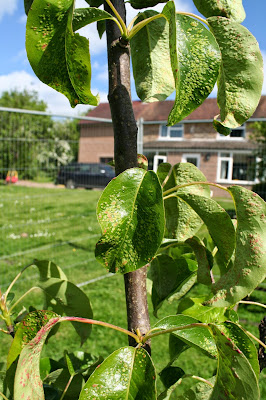I've only got the one pear tree and it was planted last year along with an apple tree when baby girl was born. Unfortunately it's succumbed to pear leaf blister mite. I suppose it must have been infected when I bought it, from what I read trees are infected from nearby affected trees and there aren't any too close to us that I can see.
I had a good search in google to identify the cause and my pears leaves look identical to all the photos.
The female mites overwinter at the base of developing leaf buds. During the period of bud swell in late winter, the mites then invade the developing leaf tissue. During Spring as the leaves emerge, blisters appear on the leaves which are a green or pink colour, due to the mites feeding on the leaves. Later in the season apparently the leaves turn black.
Succesive generations of mites are produced throughout the growing season, infecting most of the tree and nearby trees. The budding fruit is also infected and the mite cause a russetting effect in the pears.
Most sources say that this mite doesn't have a serious detrimental effect on the tree, although it drops it's leaves sooner, which suggests that perhaps it is not gathering as much strength for the coming winter.
Unfortunately I can't seem to find any domestically available treatment. As the mites live in the blisters they produce they are shielded from any chemicals sprayed. The other suggestion is to remove all infested leaves. I don't think anything will kill my tree faster than removing all the leaves, as every one was infested from budding. The only other suggestion I have found is to use dormant oil or horticultural oil.
Most commercially available horticultural oils are refined from petroleum oil with an added emulsifying agent to allow the oil to be mixed with water for application to the trees.
The main difference between dormant oils and horticultural oils is that they are more highly refined than past dormant oil products and they can be used year-round. Dormant oils which are less well refined would kill foliage so were used over winter. These are both said to be effective on pear leaf blister mite if used between November and early spring when the buds break.
I've had a search around and can only find one horticultural oil product that I can buy in the UK, although like with many things it just may have a different name here. The birth of the internet has meant information is easily obtained but products are often not international.
Anyone have any experience with pear tree blister mite or the use of dormant or horticultural oils? Any other suggestions would be welcome.



Interesting post, and will keep a watchful eye on our fruit trees, especially our pear trees.
ReplyDeleteMany years ago, as part of our preparations, my wife and I planted fruit trees in our meadow. Unfortunately, I also bought two black Nubian goats to keep the grass down in the meadow at the same time. The goats ate the fruit trees, the side of my log home, and the exposed electrical wiring under my truck, but they never ate the grass.
ReplyDeleteOh my goodness that looks awful. I don't know anything about oils and such but should probably learn. I have a friend that uses oils and I think it's called Neem? We have a really huge, old apple tree on our property. There would be no way to spray it, as it's HUGE. I wonder if older, more heirloom varieties are more tolerant to stuff like this. Just a thought.
ReplyDeleteI had to laugh at Harry's comment. Sounds like something I would do!
Cindy Bee
Awesome bloog you have here
ReplyDelete